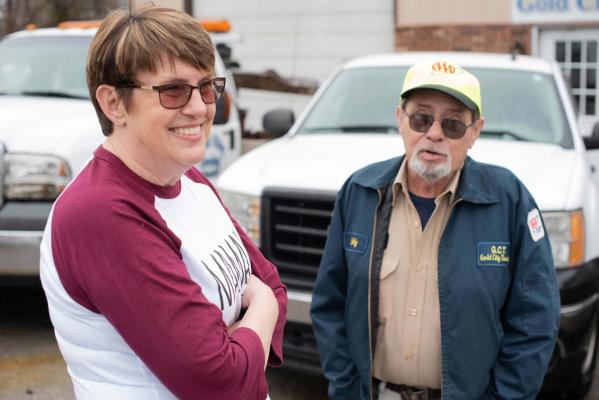Lung cancer treatment may involve a combination of medication, radiation therapy and surgery.
Lung cancer medications have improved a great deal in recent years. We now have many new and more effective drugs that produce fewer side effects and help treat early and advanced stage lung cancers. There are three main types of medicine we use to treat lung cancer: chemotherapy, immunotherapy, and targeted therapy. We often use a combination of these three therapies for lung cancer.
Chemotherapy
Chemotherapy is a type of medication that works by killing cancer cells and interfering with their ability to grow and reproduce. In many cases, lung cancer shrinks from chemotherapy. Chemotherapy with surgery or radiation is an option for people who have early-stage lung cancer before cancer spreads to other parts of the body.
Chemotherapy for lung cancer is typically given through an IV in an outpatient setting. Most people have mild or moderate side effects from chemotherapy for lung cancer. Many people with lung cancer can receive chemotherapy for several years without having severe side effects. Patients who have lung cancer often live longer and feel better with chemotherapy than without it. This is because the side effects from chemotherapy typically are often mild to moderate. Chemotherapy also offers a substantial chance of shrinking the cancer and reducing cancer symptoms.
Your specific treatment options will depend on the type and stage of the lung cancer. You may get drugs in combination with surgery or radiation. There are many chemotherapy and other drug options for treating lung cancer, so if the cancer doesn’t respond to a particular drug, we can often try another one.
Immunotherapy
Your immune system helps you fight off infections from bacteria, viruses and diseases, including cancer cells. But cancer finds ways to defend itself from the immune system. Immunotherapy drugs work by preventing that defense so the immune system can do its job. We use immunotherapy by itself and along with chemotherapy.
Immunotherapy is used for people with early-stage lung cancer before or after surgery or after radiation therapy. We also use it for advanced lung cancer that has spread to other parts of the body. We look for certain biomarkers, or characteristics, to help us predict if a specific lung cancer might respond to immunotherapy. People typically handle immunotherapy well. But as with any medication, there is a risk of side effects.
Studies show immunotherapy improves survival and well-being for people with early lung cancer. It has also improved the chance of well-being and longer survival for people with advanced stage lung cancer, where the tumor has spread to the other lung or other organs.
Targeted therapy
Molecular targeted therapy drugs look for proteins in cancer cells that cause or promote cancer cell growth. These drugs, which are often given in a pill, can stop cancer from growing and kill cancer cells.
Targeted therapy drugs are developed to attack abnormal proteins caused by mutations and other gene alterations, or changes. The proteins have an important role in promoting cancer cell growth and cancer cell survival. Molecular targeted therapy is used after surgery for early-stage cancer. We also use it for advanced cancer that has spread to other parts of the body.
Targeted therapies come in many different forms, each aimed at specific aspects of lung cancer. These treatments often lead to significant improvements, allowing people to live longer and feel better than they would without treatment.
Most targeted therapies are generally easy to tolerate. It's important to remember, though, that any medicine may cause side effects.
Radiation therapy is a treatment for lung cancer that uses high-energy X-rays. A machine directs the rays of energy to the area of cancer, with a goal to kill or shrink cancer cells.
Radiation is most often used along with other lung cancer treatments, like surgery or chemotherapy. Your doctor may advise radiation to:
- Serve as the main treatment, sometimes along with chemotherapy.
- Shrink a lung tumor to make it easier to operate on before surgery.
- Kill any remaining small areas of cancer following a surgery.
- Treat a single area of cancer spread, such as a tumor in the brain or an adrenal gland. This may be done along with surgery to treat the lung tumor.
- Relieve symptoms such as pain, bleeding, trouble swallowing, cough or problems caused by a spread of cancer.
Types of radiation therapy include:
- External beam radiation therapy. This treatment is the most common type of radiation therapy used to treat lung cancer. This treatment focuses radiation from outside the body on the cancer to eliminate cancer cells.
- Stereotactic body radiation therapy (SBRT). This treatment delivers high-dose radiation to tumors while sparing nearby healthy tissue. We use SBRT to treat small tumors in the lungs and as an alternative to surgery.
- Brachytherapy (internal radiation therapy). This treatment type is used to shrink the size of tumors in the airways to relieve painful symptoms. Your doctor will place a small source of radioactive material into the cancer or the airway where that cancer lives. The material is usually removed after a short time. This treatment is often performed using a bronchoscope but may also be done during surgery.
Learn more about our radiation oncology services.
Surgery may not be right for everyone. Your doctor will talk to you about your options and discuss the treatment that’s best for your health and the type of lung cancer. Your surgery options will depend on several factors:
- Age
- Overall health and other conditions
- Lung function
Our goal for lung cancer surgery is to remove the cancer and leave you with as much healthy lung function as we can. We may remove a small part of your lung, a larger area or the entire lung.
Types of lung cancer surgery
Surgery is a common treatment for lung cancer. We may remove:
- A wedge, or small section of the lung
- A segment, or larger area of the lung
- A lobe, one of the five main sections of the lungs
- An entire lung
Depending on your health and the details of your cancer, surgeons can perform surgery using minimally invasive techniques or open surgery.
Minimally invasive surgery
Minimally invasive surgery is the most common type of lung cancer surgery. These procedures use two to four small incisions and can lead to shorter hospital stays, less pain and shorter recovery time. The two types of minimally invasive surgery we use are:
- Video-assisted thoracoscopic surgery (VATS): During VATS, the surgeon uses a tiny camera and specialized tools inserted through small incisions in the chest. The camera lets the surgeon see inside the chest. VATS is also called thoracoscopy.
- Robot-assisted surgery: This type of surgery is similar to VATS. The surgeon uses robotic arms to perform the surgery. Robot-assisted surgery offers enhanced precision and flexibility beyond traditional techniques.
Open surgery
Some people aren’t good candidates for minimally invasive surgery. Before determining the best surgery option for you, we consider the size, location and stage of the tumor. We also look at your overall health and any other treatments you’ve had.
Open surgery (also called a thoracotomy) is a proven approach for removing lung cancer. During open surgery, we use a larger incision in the chest to remove cancer and part or all of the lung.

























